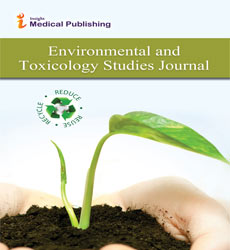Abstract
Evolution of organochlorine and organophosphorus pesticides' residues in Akkar region in Lebanon linked to an evaluation of their toxicity using E.coli K12, Pseudomonas aeruginosa H103, and Salmonella enterica
Lebanon’s agriculture represents 2.92% of its economy [1] and it is mainly used to feed the country even if part (potato, cereals, citrus fruits, etc.) is also exported to other countries (Kuwait, Qatar, Saudi Arabia, etc.) [2]. However, intensive and unregulated use of pesticides in the agricultural regions of the Northwest of Lebanon, specifically in Akkar (second agricultural region in terms of surface area) has generated contamination of the water resources adjacent to the cultivation areas
[3] [4] [5]. The inhabitants of this region use groundwater as the main source of drinking water but also for irrigation [6]. Thus, the risks associated with this deterioration in the sanitary quality of water induced researchers to try to set up programs to monitor the evolution of the levels of organic pollutants from 2014. The aim of this study was to assess the evolution of groundwater contamination by two classes of pesticides (organochlorines - OCPs, organophosphates - OPPs) in wells in Akkar plain, based on two studies carried out in 2014 and 2016 [4] [7] and on a work currently being carried out, also this study try to evaluate the toxicity of exicted pesticides in this wells using three different types of bacteria : E.coli K12, Pseudomonas aeruginosa H103 and salmonella enterica, diffrents tests has done (created) to conclude the effect of those pesticide upon these bacteria.
II. Material and methods
Water samples were taken from 14 wells and then conditioned to allow the isolation of pesticides. A methodology implementing a solid phase cartridge extraction (SPE, HLB) followed by an analysis by gas chromatography coupled to a mass spectrometer (GC / MS) was implemented and validated to allow quantification of the pesticide content. As for toxicological evaluation, four commune test were selected to identify the growth of these bacteria with the presence of these pesticides, their mobility, morbidity and ability to form a biofilm, then specific virulent gene for each bacteria were selected to interpret the ..
III. Results
The results showed that the levels of organochlorine pesticides identified in Akkar’s groundwater exceed the limits set by the Stockholm Convention on Persistent Organic Pollutants. OPPs and OCPs are detected at similar significant levels (from a few µg / L to almost 60 µg / L). In addition, the concentration of several molecules seems to increase gradually since 2014. Different ratios, including αHCH / γ-HCH and 2,4’-DDT / 4,4’-DDT, were used in order to identify the main sources and hostorical use of pesticides. Thus it appears the lindane and the DDT found would be linked to a still recent use. An interesting effects on bacteria growth were seen after being in contact with these pesticides while some of them feed on these molecules while other were tolerated by, add to that their ability to form a bioflm and the variation in the expression of their virulent gene. All of these observations show that changes in the practices of use of phytosanitary products (education and training of farmers ; establishment of regulations : eg protection near catchments) are necessary, as is the establishment of more systematic monitoring of these residues, particularly in the case of wells used for water supply.
Biography
Roukaya AL HAJ ISHAK AL ALI is a PhD candidate in analatycal chemistry (second year) in Poitiers university in France. She is 26 years old, working on pesticides’s quantification in a rural region and study the virulence effects of this pesistants organic polluants on three bacteria’s model.
Speaker Publications :
[1] H. Plecher, Lebanon : Share of economic sectors in the gross domestic product (GDP) from 2008 to 2018, 8 Janaury 2020.
[2] IDAL « Investment Development Authority of Lebanon », Agriculture sector, 2017.
[3] M. Baroudi, H. Bakkour, J. Halwani, S. Taha, R. El-Osmani, AH. Mouneimne, 2012, Determination of pesticide, nitrates and nitrites level in groundwater of Akkar plain in north Lebanon, J. Appl. Sci. Res 8:4663-4667.
[4] R. El-Osmani, S. Net, D. Dumoulin, M. Baroudi, H. Bakkour, B. Ouddane, 2014, Solid Phase Extraction of Organochlorine Pesticides Residues in Groundwater (Akkar Plain, North Lebanon), International Journal of Environmantal Research 8 : 903-912.
[5] J. Halwani, B. Ouddane, M. Baroudi, M. Wartel, 1999, Contamination par les nitrates des eaux souterraines de la plaine d’Akkar au Liban du Nord. Chaiers d’études et de recherches francophones/ Santé 9:219-223.
[6] Ministry of energy and water, 2010, Lebanese goverment.
[7] C. Chbib, S. Net, M. Hamze, D. Dumoulin, B. Baghdad, M. Baroudi, 2016, Assesment of pesticides contamination in groundwater of Akkar (Northen Lebanon) by a combined of offline SPE with GC/MS, Environmental Science and Pollution Research.
Author(s): Roukaya AL HAJ ISHAK AL ALI
Abstract | PDF
Share This Article
Google Scholar citation report
Citations : 184
Environmental and Toxicology Studies Journal received 184 citations as per Google Scholar report
Abstracted/Indexed in
- Google Scholar
Open Access Journals
- Aquaculture & Veterinary Science
- Chemistry & Chemical Sciences
- Clinical Sciences
- Engineering
- General Science
- Genetics & Molecular Biology
- Health Care & Nursing
- Immunology & Microbiology
- Materials Science
- Mathematics & Physics
- Medical Sciences
- Neurology & Psychiatry
- Oncology & Cancer Science
- Pharmaceutical Sciences

